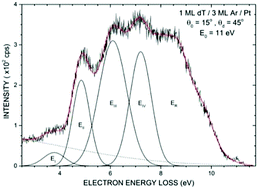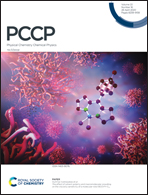Low energy (6–18 eV) electron scattering from condensed thymidine (dT) III: absolute electronic excitation cross sections
Abstract
Absolute cross sections (CSs) for electronic excitation by low-energy electron (LEE) scattering, from condensed thymidine (dT) in the 6–18 eV incident energy range, were measured by high-resolution electron energy loss spectroscopy (HREELS). Various electron energy loss (EEL) spectra were acquired using 1 ML of dT condensed on a multilayer film of Ar held at about 20 K under ultra-high vacuum (∼1 × 10−11 Torr). dT is one of the most complex DNA constituents to be studied by HREELS and these spectra provide the first LEE energy-loss data for electronic excitation of a nucleoside. CSs for transitions to the states 13A′, 13A′′, 23A′, 21A′, 33A′, 23A′′, 43A′, 33A′′, 53A′ and 51A′ of dT were extracted from the EEL spectra. These states correlate to those previously measured for the thymine moiety. Two broad resonances are observed in the energy dependence of the CSs at around 8 and 10 eV; these energies are close to those found in earlier gas- and solid-phase studies on the interaction of LEEs with dT, thymine and related molecules. A quantitative comparison between the electronic CSs of dT and those of thymine and tetrahydrofuran indicates that no variation is induced in the electronic CSs of thymine upon chemically binding to a deoxyribose group.

- This article is part of the themed collection: 2020 PCCP HOT Articles


 Please wait while we load your content...
Please wait while we load your content...